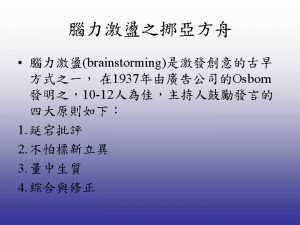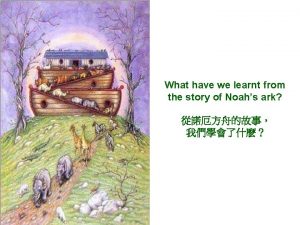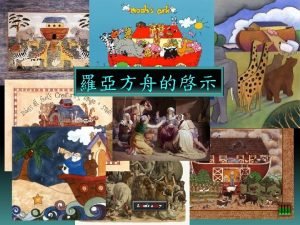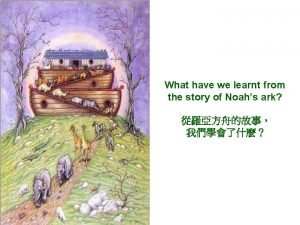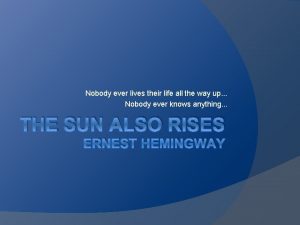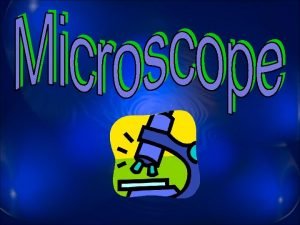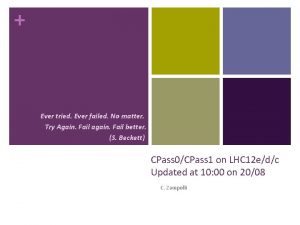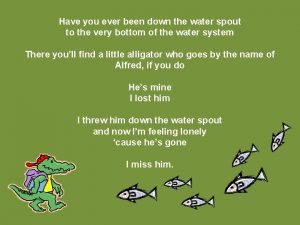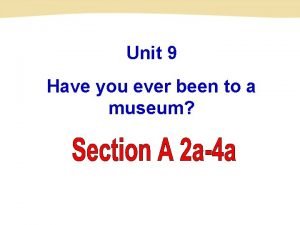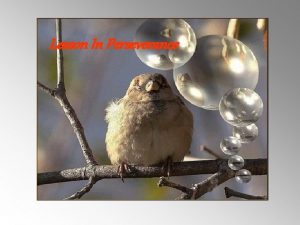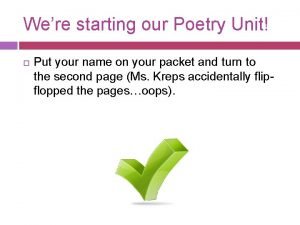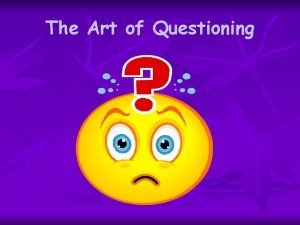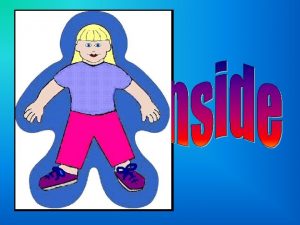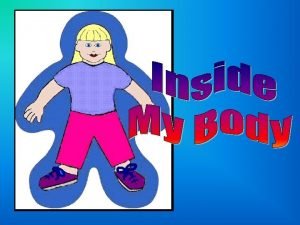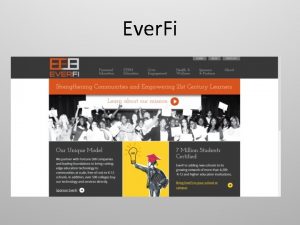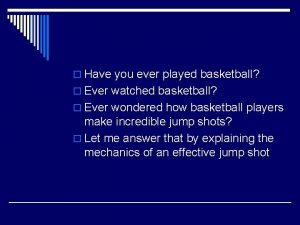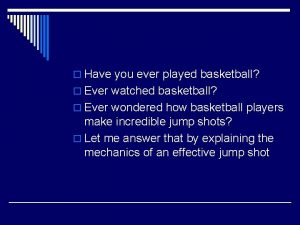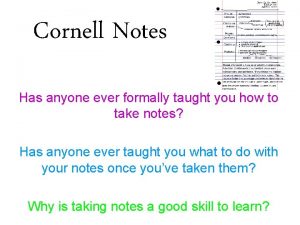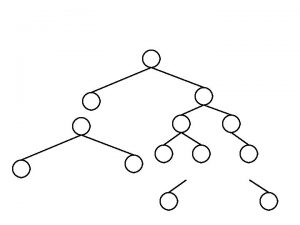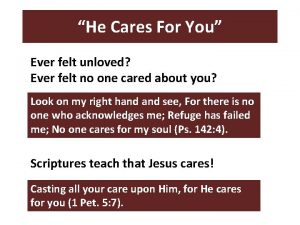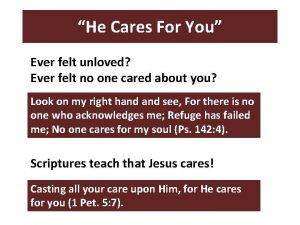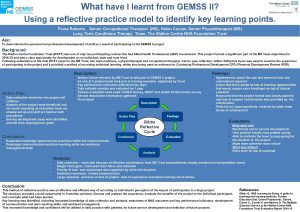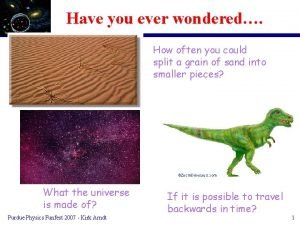Have you ever learnt or taught English using





























- Slides: 29

• Have you ever learnt or taught English using the audiolingual method? • Was it effective? • What, if any, problems did you have?




• Now your turn to do with your classmates Drills 4 -5 -6 -7

Communicative Language Teaching

Communicative Language Teaching • Communicative Language Teaching (CLT) started in the late 1960 s and continues to evolve. It is not actually a method but an approach to teaching based on the· view that learning a language means learning how to communicate effe_ctively in the world· outside the classroom

• It developed mainly as a reaction to the limitations of previous methods which put little; if any, emphasis on the ability to communicate or interact.

Features • Here are some of the main features of CLT: • - The goal is to learn to communicate in the target language. • - There is an emphasis on meaning and using the language rather than on the structure and form of the language. • - Oral and written activities may be used from the start, for example, role plays, dialogues, games, . and problem-solving.

• - Oral and written activities may be used from the start, for example, role plays, dialogues, games, . and problem-solving. • - One role for the teacher is that of a 'facilitator' who helps learners to communicate in English and motivates them to work with the language. • - Learners often interact with each other through pair or group work. • - The four skills are developed simultaneously

• Many CLT classrooms use a Presentation-Practice-Production or PPP model of teaching. The teacher first 'presents' the new language, possibly by playing a recorded dialogue or getting the learners to read a written text.

• Then the learners 'practise' the new language in a controlled way, possibly by completing written exercises using the new language or· in controlled pair work practising similar dialogues. Finally, the learners 'produce' the language in a freer activity that allows them to communicate, hopefully using the language they have just studied.

• Everyday English

• Finally, they can produce. the language more freely by giving directions to places they actually know, possibly using real maps brought into the classroom for this· purpose by the teacher or drawn by the learners themselves.

• Role playing is a common feature of the CLT classroom and involves the learners acting as someone else, for example, a customer, a ticket sales person, etc. in a situation where they need to use English, for example, to order a meal or buy tickets at a railway station. In this case, one learner would be the customer asking questions about the train times and ticket prices, etc, while another would be the ticket seller giving the information. •

• • • • ‘Do You Know Where My Book Is? ’ Where are my pencils? Cem : Hey Ali , do you know where my pen is? Ali: Yes, it is on your desk. Cem : Okay thanks. Hey Fatih, do you know where my eraser is? Fatih : Yeah, it is on your bed. Cem : Okay thanks. Hey Aktug, do you know where my ruler is? Aktug : Yeah, it is between the books Cem : Okay thanks. Hey Azra, do you know where my sharpener is? Azra : Yeah, it is in your pencil case. Cem : Okay thanks. I have everything I need. Now I can go to school. Fatih: Hey Cem, do you know where your pencils are? Cem : No. Where are they? I need them.

• • • Who's going to the cinema? We are. Who's been to the cinema? We have. Who goes to the cinema? We do. Who went to the cinema? We did. Who'll go to the cinema? We will.

• 1 John is (short) than Paul. • 2 Your boots are (dirty) than mine. • 3 This garden is (attractive) than the other one.

• CLT is very widely used in language teaching all over the world. It has shifted the focus in language teaching from learning about the language to learning to communicate in the language. However, there are problems associated with. CLT:

• - The emphasis on pair and group work can create problems in some classes. Some learners, particularly adults, think it is a waste of time talking to other L 2 speakers rather than a nativespeaker teacher. • - Native-speaker teachers do not need to know much about the language in order to become teachers. • - The approach can lead to too much emphasis on speaking and listening;

• - Dividing the language up into discrete units under the headings of • 'vocabulary', 'grammar', and 'functions' and the four skills is misleading. Communication involves using all these elements simultaneously. • - Learners do not necessarily learn what they are taught, i. e. the discrete language items, in the order that they are taught.

• The most serious criticism of CLT is that it is not as effective as it claims to be. A lot of learners complete their studies but are still unable to communicate in English. One reaction to this has been to change the learning focus from the content, i. e. the structures, functions, and vocabulary to the process, that is 'to use English to learn it' rather than 'to learn to. use English'. This brings us to the next model of learning, Task-Based Learning.

Task-Based Learning • Task-Based Learning (TBL) focuses on the 'process' of communicating by setting learners tasks to complete using the target language. During this process, it is claimed, the learners acquire language as they try to express themselves and understand others.

• The tasks can range from information gap to problem-solving tasks. One advantage of TBL is that learners are given the opportunity to use the full range of skills and language they have at the same time, rather than in discrete units, as, they sometimes do with the CLT model.

A typical task sequence may include: • - pre-tasks: these are activities which prepare learners to complete a task, for example, by guiding learners through an example. of the task they will have to do. There can be a number of pre-tasks in one lesson. · • - tasks: these form the main body ofthe lesson and can involve a number of steps. For example, learners working in pairs or groups may first complete the task, then prepare a report on the task, and finally present the report to the class. • - post-tasks: these move away from activities designed to promote fluency to those designed to promote accuracy.

All in all • Teaching. has been influenced by a wide variety of methods and trends. New methods have been introduced as part of the ongoing search for the. 'best' way to teach. In some ways this has been beneficial - we now know a lot more about teaching and learning than we did 50 years ago, and the learner's role has been integrated into the learning and teaching process.

• However, . some ways of teaching that might still be useful translation, using a situa • tion to demonstrate meaning, and drilling, to take three examples - have been sidelined. At the same time, teachers have constantly had to keep up with the latest trends which may or may not be appropriate for them or their learners.

• We are now at the point where there is more emphasis on teachers and learners making their own choices about how to teach and learn. Teachers can use the back-catalogue of methods as a starting point to make decisions about this process.

So……. . • • • - the Grammar-Translation Method - the Direct Method - Audiolingualism - Communicative Language Teaching - Task-Based Learning.
 What have we learnt from the story?
What have we learnt from the story? What have we learnt from the story? *
What have we learnt from the story? * What have we learnt from the story?
What have we learnt from the story? What have we learnt from the story?
What have we learnt from the story? What have we learnt from the story?
What have we learnt from the story? Ever ancient ever new
Ever ancient ever new Clarified it
Clarified it Have you ever looked
Have you ever looked Ever tried ever failed no matter
Ever tried ever failed no matter L have just learnt to
L have just learnt to I wish my parents would
I wish my parents would Pismeni zadatak
Pismeni zadatak Have you ever wondered
Have you ever wondered Walmart shrinkage statistics
Walmart shrinkage statistics Handcuffs
Handcuffs Ya aburnee arabic
Ya aburnee arabic Have you ever climbed a mountain
Have you ever climbed a mountain Have you ever been down
Have you ever been down Have you ever ridden a camel?
Have you ever ridden a camel? Have you ever climbed a mountain
Have you ever climbed a mountain Have you ever seen a greenhouse
Have you ever seen a greenhouse Have you seen this area before?
Have you seen this area before? Have you ever watched people
Have you ever watched people Have you ever seen a sheet on a river bed poem
Have you ever seen a sheet on a river bed poem How are you
How are you Have you ever been to a zoo?
Have you ever been to a zoo? Arts of questioning
Arts of questioning Have you ever seen a penguin come to tea
Have you ever seen a penguin come to tea You ever looked in the mirror and thought
You ever looked in the mirror and thought Have you ever looked in the mirror
Have you ever looked in the mirror
